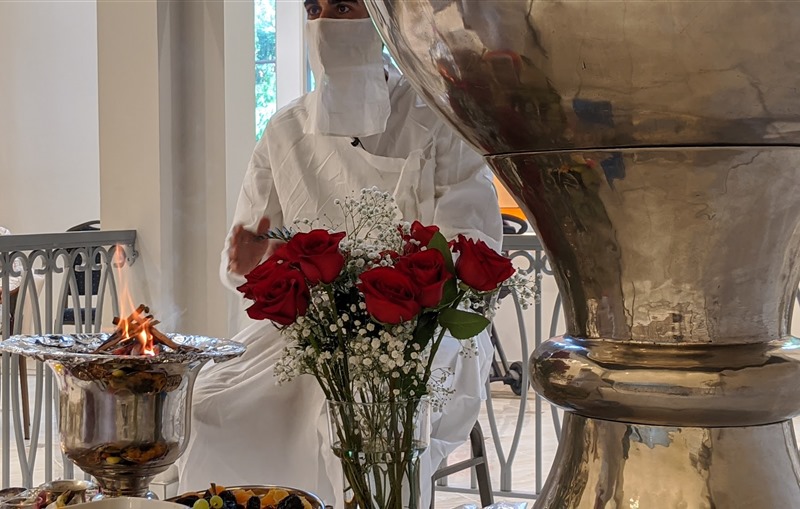Our dear friend Ervad Adil Minocherhomjee makes a very compelling case about priesthood in the Zoroastrian Faith…
Why We Don’t Make Mobeds or Consecrate Fires Like We Used To—And What That Says About Us
Let’s stop pretending we’re still making Mobeds. Or Dastoors. Or Atash Behrams. Not in the way our ancestors did. Not in the way the architecture demands.
To understand what we’ve lost, we have to first understand what it took.
To be a Mobed wasn’t just to memorize a few prayers or stand before a fire. It was to be initiated into a lineage. Trained in the sacred texts. Fluent in Avestan and Pazand. Literate in ritual law, cosmology, purification, and metaphysical boundaries. A Mobed wasn’t just a functionary. He was a bridge between geti (the physical) and mino (the spiritual), between creation and Creator.
But a Mobed was never the top. He was a rung on a sacred hierarchy.
Below him stood the Herbad—still trained, still respected, but limited in the rituals he could perform. Above him was the Dastoor—the spiritual general, not just executing rites but interpreting them. And above even that, in rare times and rarer communities, there was the Dastooran Dastoor—the one who held the moral compass for all others. This was not a metaphorical pyramid. It was a structure as sacred as the Atash Behram it supported.
We don’t just lack Dastoors now. We barely recognize Herbads. And most who call themselves Mobeds today—myself included—aren’t initiated into this hierarchy in any real, living sense. The priesthood hasn’t just thinned. It’s flattened.
Your navar didn’t make you a Mobed. Your life did. But now we give the title out like a courtesy, a placeholder for what once required an entire system of mentorship, mastery, and metaphysical accountability.
I know this because I “am” one. I once performed a jashan where the family Venmo’d me $75 and forgot my name.
And consecrating an Atash Behram? That was the priesthood’s magnum opus. The pinnacle of sacred labor. A feat that only a coordinated, committed community could carry to completion. A Mobed may have served his people day after day, but building an Atash Behram was the one act that placed him inside cosmic history.
The consecration of an Atash Behram—the highest fire in Zoroastrianism—isn’t just ceremonial. It’s cosmic engineering. It requires sixteen distinct fires, each drawn from a different domain of human and divine experience, each purified through months (sometimes years) of ritual precision.
Each fire was more than a source. It was a worldview.
-
Fire from a potter’s kiln
-
Fire from a goldsmith’s forge
-
Fire from a brickmaker’s oven
-
Fire from a dyer’s workshop
-
Fire from the hearth of a king or ruler
-
Fire from a warrior’s fire (hunter or soldier)
-
Fire from a shepherd’s campfire
-
Fire from a priest’s hearth
-
Fire from a blacksmith’s forge
-
Fire from a baker’s oven
-
Fire from a brewer’s still or distillery
-
Fire from a funeral pyre (intensely purified due to its association with death)
-
Fire caused by a lightning strike
-
Fire from the hearth of a righteous Zoroastrian
-
Fire from an already sacred altar or temple
-
Fire generated by striking flint stones together
Each fire represented a facet of society—labor, virtue, kingship, death, elemental force. Each one ritually purified. Each one merged into something more than symbolic. The final fire wasn’t just sacred. It was asha itself—truth, order, harmony—made visible through flame. It was ontology, not metaphor.
But here’s the truth most of us know but never admit aloud: we don’t consecrate like this anymore.
Not in Udvada. Not in Mumbai. Not anywhere. We might still light the fires. We might still call them Atash Behrams. But the full ritual—the sixteen flames, the months of purification, the chorus of Mobeds chanting the Vendidad in synchronized cycles—that version of the sacred is mostly memory.
And it’s not just because we’re incapable or untrained.
It’s because you—the laity—have stopped asking for it. You no longer pay for it. You no longer show up for it. You no longer make room in your lives to sustain it.
You’ve professionalized everything except the sacred. You’ll pay top dollar for tutors, therapists, architects—but expect Mobeds to show up in white pajamas, chant timeless liturgy, and then disappear quietly without expectation or compensation. You treat the priesthood like a cultural backdrop—something to be seen but not invested in.
That ends now.
Because if you’re reading this, and you’re comfortable with a world where the people who bury your dead, bless your children, and carry your lineage get paid less than your mehndi artist—you’re part of the problem.
Mobeds today are often part-time, underpaid, and barely supported. Many are self-taught. Some are deeply trained, but underutilized. Others serve only for ceremonies. Some still carry the weight of initiation and tradition. Many do not. That isn’t failure. That’s response. To the absence of demand. To the erosion of value. To the disappearance of meaning from the communal side.
We say we want continuity, but we don’t act like it.
We say we value tradition, but we leave its stewards unpaid.
We say we believe in fire, but we won’t fund its keepers.
Would anyone today commit to a full Mobed or Dastoor training if we offered it? Maybe. But we wouldn’t fund them. We wouldn’t celebrate them like we do MBAs or engineers. We’d applaud them for their “passion project,” but not offer them a livelihood. We mourn the loss of the priesthood in theory, but don’t make space for it in practice.
Instead, we’ve substituted our spirituality. WhatsApp prayer circles. Instagram tributes. Emoji-filled forwards. The Mobed used to know your family history, your karma, your pain. Now we send our intentions into the void and hope someone double taps.
As the Vendidad reminds us, “The fire of Ahura Mazda is kept burning by the one who chooses righteousness in word and deed.” But what happens when righteousness is no longer a communal priority? When families who once funded fire temples now ask for same-day delivery on prayers? When the community itself loses its appetite for continuity?
This isn’t shameful. It isn’t laziness. It’s the honest cost of continuity in a community that no longer invests in its own metaphysics.
So yes, we are flattening.
Linguistically. Liturgically. Ontologically. Hierarchically.
What would it take to consecrate an Atash Behram in full today? A decade of planning. A million-dollar budget. Twenty Mobeds trained to chant the Vendidad for months. A community willing to pause, fund, and believe—not for a day, but for a year. If we can’t name the human infrastructure it would take, that’s not because it’s impossible. It’s because we’ve already decided we won’t try.
You’ll fund destination weddings. Pay for Ivy League degrees. Shell out for meditation retreats. But you can’t justify paying the people who carry our souls?
And if the sixteen fires once reflected society’s totality, what does it mean that modern society no longer reflects into the fire? The fire is no longer a mirror. It’s a museum. The professions the fires once came from—potter, shepherd, king—aren’t just endangered. They’re forgotten. The symbolic range of human life has shrunk.
But maybe there’s a seventeenth fire now. The fire of disconnection. Of diaspora. Of doubt. It’s the one we don’t know how to purify—because it’s inside us. And maybe, if we can name it, we can learn to sanctify it too.
So yes, maybe we can’t light sixteen fires anymore. But I still wake up trying to keep one burning. The fire of memory. The fire of refusal. The fire that says: this still matters.
What would a meaningful priesthood look like today? Not one that just preserves rituals, but interrogates why they’ve faded. A Mobed who serves as guide, not gatekeeper. Part liturgist, part witness, part translator of loss. Maybe the next Mobed won’t be found only in fire temples. Maybe they’ll teach the Gathas over a podcast. Host digital mukhtads with meaning. Translate Avestan into action. Maybe our firekeepers will become bridge-builders again—if we let them. If we support them. If we remember how.
Are we flattening toward extinction or reinvention? Some days I don’t know. But I still believe reinvention is a choice. And extinction isn’t inevitable. It depends on whether we can light a fire that doesn’t need sixteen sources—just one soul willing to tend it.
We are not in the age of consecration.
We are in the age of maintenance.
And in that, there is still sanctity.
Not in the structure.
But in the stubborn, sacred choice to refuse extinction.
I wrote this not to mourn what’s lost, but to name what still burns.
I wrote this as a Mobed who is not sure what that title means anymore, but still wakes up trying to make it mean something.
Because some of us still remember what fire is. And we’re still here. Not to preserve the illusion—but to keep the heat.
So if the flame has dimmed—who among us will kindle it again?
Not with incense and recitation, but with investment and intention?

